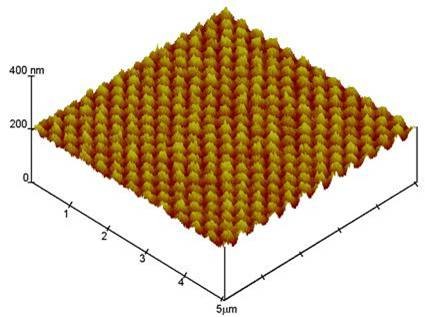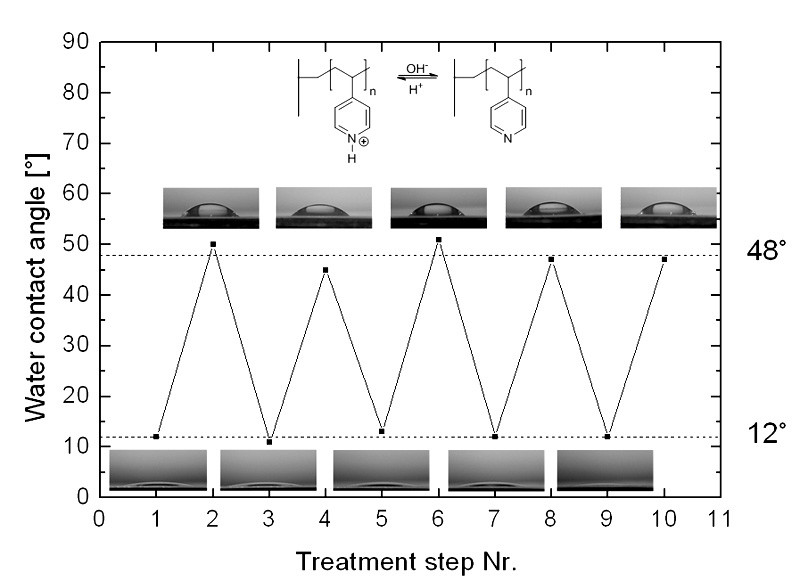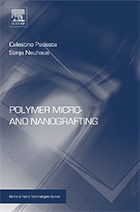Polymer Micro and Nanografting
The combination of selective irradiation of polymer materials with photons to create active radical species with a subsequent graft polymerization reaction is a unique technique to produce micro- and nanostructured polymer materials. A key feature of the technology is the possibility to combine the properties of a polymer substrate in precisely defined regions with properties of the grafted materials, resulting e.g. in local electrical or ionic conductivity, biological activity or surface functionality.
Radical species are formed when photons or particles of engeries high enough to break chemical bonds are absorbed by polymer materials. Radicals created at the surface may be used as initiators for polymerization reactions, leading to the growth of polymer brushes. In our work we are using EUV-radiation, e-beam exposures as well as Helium or Argon plasma sources for surface activation. A simple process scheme can be found here.
>> Recent updates:
Radical species are formed when photons or particles of engeries high enough to break chemical bonds are absorbed by polymer materials. Radicals created at the surface may be used as initiators for polymerization reactions, leading to the growth of polymer brushes. In our work we are using EUV-radiation, e-beam exposures as well as Helium or Argon plasma sources for surface activation. A simple process scheme can be found here.
>> Recent updates:
- Research Highlight: Light-switching of enzymatic activity on orthognonally functionalized polymer brushes
- New on the Internet: ACS LiveSlides™ presentation on our recent publication on responsive membranes
Nanostructured brushes via EUV-IL exposures
The technology to graft nanostructured polymer brushes takes advantage of the unique structuring capabilities of the EUV interference beamline at SLS, which enables the formation of patterns of radicals with sub-100-nm resolution. Our work in this field includes:
Structure definition and reaction control
• Reaction control using RAFT polymerization
• Influence of solvent viscosity on surface grafting
Functional Polymer Brushes
• Biofunctional Brushes
• Responsive polymer brushes
• Polyelectrolyte multilayers on structured brushes
• Metal and metal oxide nanocomposites
Current research Focus: Polymer brushes as biointerfaces.
Structure definition and reaction control
• Reaction control using RAFT polymerization
• Influence of solvent viscosity on surface grafting
Functional Polymer Brushes
• Biofunctional Brushes
• Responsive polymer brushes
• Polyelectrolyte multilayers on structured brushes
• Metal and metal oxide nanocomposites
Current research Focus: Polymer brushes as biointerfaces.
Large area functionalization using plasma activation
For the creation of radical initiators for large-area grafting, plasma sources operated with inert gases can be used. For low-pressure activation the area which can be activated and grafted is mainly determined by the size of the plasma chamber. The recenly developed atmospheric-pressure plasma systems proved to be well suited for a very quick but still reliable activation of smaller areas of up to a few cm2. Shadow masks can be employed for a selective actication and grafting of well definde areas on a substate. Plasma-induced grafting has been used for:
• Functionalization of Polymer foils with poly-electrolyte brushes
• Functionalization of pre-structured polymer foils
• Formation of wettabilty gradients
• Creation of Bio-functional surfaces
• Functionalization of Polymer foils with poly-electrolyte brushes
• Functionalization of pre-structured polymer foils
• Formation of wettabilty gradients
• Creation of Bio-functional surfaces
Recently published
Celestino Padeste und Sonja Neuhaus
Polymer Micro- and Nanografting
Based on own work and literature reports this book provides a summary of strategies for the formation of functional polymer patterns and structures on polymeric substrates using grafting processes.
Elsevier 2015; ISBN: 978-0-323-35322-9
Online Edition Elsevier Book Store
Celestino Padeste und Sonja Neuhaus
Polymer Micro- and Nanografting
Based on own work and literature reports this book provides a summary of strategies for the formation of functional polymer patterns and structures on polymeric substrates using grafting processes.
Elsevier 2015; ISBN: 978-0-323-35322-9
Online Edition Elsevier Book Store
Selected Papers
M. Dübner, V.J. Cadarso, T.N. Gevrek, A. Sanyal, N.D. Spencer, and C. Padeste"Reversible Light-Switching of Enzymatic Activity on Orthogonally Functionalized Polymer Brushes"
ACS Appl. Mater. Interfaces, 2017, 9 (11), pp 9245-9249
M. Dübner, M.E. Naoum, N.D. Spencer, C.Padeste,
“From pH- to Light-Response: Post-Polymerization Modification of Polymer Brushes Grafted onto Microporous Polymeric Membranes”,
ACS Omega, 2, 2017, 455-461., ACS LiveSlides™ presentation
K. Gajos, V.A. Guzenko, M. Dübner, J. Haberko, A. Budkowski, C. Padeste
"Electron-beam lithographic grafting of functional polymer structures from fluoropolymer substrates"
Langmuir 32(41), 2016, 10641–10650
M. Dübner, T.N. Gevrek, A. Sanyal, N.D. Spencer, C. Padeste
"Fabrication of Thiol-Ene "Clickable" Copolymer-Brush Nanostructures on Polymeric Substrates via Extreme Ultraviolet Interference Lithography",
ACS Appl. Mater. Interfaces 2015, 7, 11337–11345.
M. Dübner, N.D. Spencer, C. Padeste,
"Light-Responsive Polymer Surfaces via Postpolymerization Modification of Grafted Polymer-Brush Structures",
Langmuir, 30 (2014) 14971−14981
S. Neuhaus, N.D. Spencer, C. Padeste,
“Anisotropic Wetting of Microstructured Polymers as a Function of Surface Chemistry”,
ACS Applied Materials and Interfaces 4 (2012) 123-127
S. Neuhaus, C. Padeste, N.D. Spencer,
“Versatile Wettability Gradients Prepared by Chemical Modification of Polymer Brushes”
Langmuir 27 (2011) 6855–6861.
S. Neuhaus, C. Padeste, N.D. Spencer,
“Functionalization of Fluropolymers and Polyolefins via Grafting of Polyelectrolyte Brushes from Atmospheric-Pressure Plasma Activated Surfaces”
Plasma Processes and Polymers 8, 6 (2011) 512-522.
S. Neuhaus, C. Padeste, H.H. Solak, N.D. Spencer,
“Functionalization of fluoropolymer surfaces with nanopatterned polyelectrolyte brushes”
Polymer 51 (2010) 4037-4043.
P. Farquet, A. Kunze, C. Padeste, H.H. Solak, S. Alkan Gürsel, G.G. Scherer and A. Wokaun,
“Influence of the solvent viscosity on surface graft-polymerization reactions”,
Polymer, 48 (2007) 4936-4942.
H.-P. Brack, C. Padeste, M. Slaski, S. Alkan, and H. H. Solak,
„Preparation of Micro- and Nanopatterns of Polymer Chains Grafted onto Flexible Polymer Substrates”
J. Am. Chem. Soc., 126, 4 (2004) 1004-1005.


